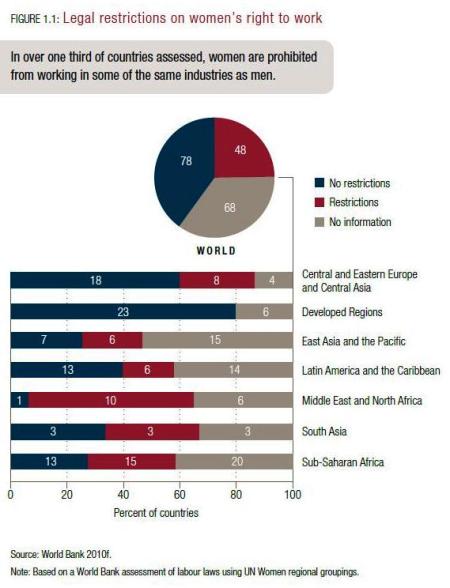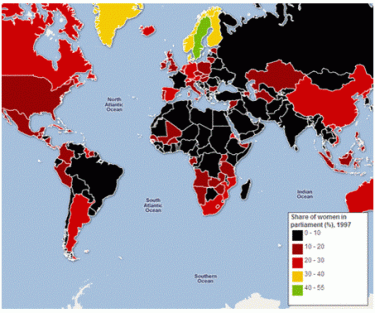Thursday, 7 March 2013
Measuring development post-2015: highlighting the poorest of the poor
Thursday, 12 January 2012
Women’s legal rights – progress and backlashes
In every region of the world, there has been a significant progress on legal reform to expand the scope of women’s rights. Law implementation and enforcement improves women’s access to justice and therefore can advance gender equality. However, a lot of work remains to be done for all women and girls to experience justice, physical integrity and equality in their homes and working places.
UN Women, the newly established United Nations Entity for gender equality and the empowerment of women recently released its biannual flagship report, ‘Progress for the World’s Women in Pursuit of Justice 2011-2012.’
The report highlights the ways in which governments and civil societies should work together to reform laws and create new models for justice service delivery that meets women’s needs. The report also sheds light on the challenge of ensuring that women can access justice in the most challenging situations, including after conflict and in the context of legal pluralism. Women themselves play a central role as agents for change, as legislators, judges, lawyers, campaigners and community activists.
The report focuses on women’s pursuit of justice and it recognizes the positive progress made all over the world, for instance about 139 countries and territories, now guarantee gender equality in their constitutions.
A remarkable advance has been made over the past century in the quest for gender equality and women’s empowerment, particularly in terms of legal rights. Today, 139 countries and territories, now guarantee gender equality in their constitutions. 125 countries have outlawed domestic violence, 115 guarantee equal property rights and women’s voice in decision-making is stronger than ever before. In many countries, legal reforms to expand women’s rights and access to justice have been followed by an increase in women’s representation in parliaments.
However, despite widespread legal guarantees of equality, the reality for many millions of women is that justice remains out of reach. This often also goes for women’s economic participation:Image Source: http://filipspagnoli.wordpress.com/2009/11/10/human-rights-maps-70-gender-equality-in-government/

Therefore, it is important to continue changing national laws, demanding enforcements of existing laws, striking down discriminatory customary laws and revolutionizing the scope of international law. Making the justice system work for women, for example by catalyzing legal reforms, supporting legal aid and training for judges, requires investment.
Most international organizations recognize the importance of strengthening the rule of, but targeted funding for promoting gender equality in the area of legal and judicial development and human rights has remained low.
In 2009, the OECD allocated $4.2 billion to justice, with US and European Union accounting for 70 per cent of the total. Out of this amount, only 5% were allocated to programs focusing on gender equality as primary aim. 15 per cent were allocated to programs for which gender equality was a secondary aim.
The World Bank has also allocated only a very small fraction of its funding to gender equality focused rule of law projects over the past decade. The Bank’s funding for grants, credits and loans for the years 2000-2010 adds up to 261 billion USD (2946 projects). 6% are allocated to rule of law projects (16 billion USD). The total amount allocated to rule of law and gender equality projects adds up to 61 million USD (0.02%).The total amount allocated to the gender equality components of these projects is only 9.6 million USD (0.004%).
By Angela Luci.
Sources: Angela Luci; The Citizen; UN Women Report
Friday, 25 February 2011
Launch of UN WOMEN: taking the first steps…
With all the attention on UN WOMEN these days, an article from the Guardian caught my eye. It is titled “Send a message to UN WOMEN” and invites readers to express their voice by sending a photo illustrating their opinions, hopes and expectations of UNWOMEN to a Flickr group created for the occasion.
On February 24th 2011, UN WOMEN, the new United Nation’s entity solely dedicated to promoting and enhancing gender equality and women’s empowerment was created. Coinciding with the week long 55th session of the Commission on the Status of Women (CSW) in New York, the launch was celebrated with a big bang by political leaders, women leaders, media personalities and celebrities. These celebrations fit in perfectly with the upcoming next few weeks of attention on gender equality, as the current CSW will continue until March 3rd only to be followed by International Women’s day on March 8th. In preparation for this launch and to comment on the first steps of this new agency, journalists and bloggers have been vocal in expressing their thoughts, expectations and even their doubts on this new UN “superagency”. This is a good thing, as it attracts attention to important issues relating to gender equality. However, what happens when all of this will die off in a few weeks’ time when the party’s over? Hopefully the creation of UN WOMEN will be able to keep the momentum on women’s advancement going, even after this month’s frenzy of activity on the topic.
The Guardian’s initiative is a great and original way to keep people involved and ask them what they think about UN WOMEN. It keeps attention on the issue of women’s empowerment rather than on institutional and bureaucratic questions. Others express concerns on the lag it took the Agency to become operational and also on its financing. But for an organisation that was long awaited by gender practitioners and advocates this seems normal, as any transition phase usually can be bumpy.
A more important concern is that by merging four international agencies and offices and centralising gender issues in one organisation, the risk is to overshadow other organisations that have projects and divisions working on gender. The biggest risk is mostly for NGOs and grassroot organisations – will they still receive adequate support and funding? Or will it all go to UN WOMEN? It is important to have one strong entity focusing on this topic but also to keep the light on other very important projects and initiatives led by more technical and specialised organisations.
Let’s wait and see….
Nejma Bouchama


